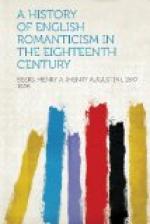The same unlikeness is found between modern works conceived in the spirit, or executed in direct imitation, of ancient and medieval art respectively. It is easy to decide that Flaxman’s outline drawings in illustration of Homer are classic; that Alfieri’s tragedies, Goethe’s “Iphigenie auf Tauris” Landor’s “Hellenics,” Gibson’s statues, David’s paintings, and the church of the Madeleine in Paris are classical, at least in intentions and in the models which they follow; while Victor Hugo’s “Notre Dame de Paris,” Scott’s “Ivanhoe,” Fouque’s “Der Zauberring,” and Rossetti’s painting, “The Girlhood of Mary,” are no less certainly romantic in their inspiration.
But critics have given a wider extension than this to the terms classic and romantic. They have discerned, or imagined, certain qualities, attitudes of mind, ways of thinking and feeling, traits of style which distinguish classic from romantic art; and they have applied the words accordingly to work which is not necessarily either antique or medieval in subject. Thus it is assumed, for example, that the productions of Greek and Roman genius were characterized by clearness, simplicity, restraint, unity of design, subordination of the part to the whole; and therefore modern works which make this impression of noble plainness and severity, of harmony in construction, economy of means and clear, definite outline, are often spoken of as classical, quite irrespective of the historical period which they have to do with. In this sense, it is usual to say that Wordsworth’s “Michael” is classical, or that Goethe’s “Hermann and Dorothea” is classical; though Wordsworth may be celebrating the virtues of a Westmoreland shepherd, and Goethe telling the story of two rustic lovers on the German border at the time of the Napoleonic wars.
On the other hand, it is asserted that the work of mediaeval poets and artists is marked by an excess of sentiment, by over-lavish decoration, a strong sense of color and a feeble sense of form, an attention to detail, at the cost of the main impression, and a consequent tendency to run into the exaggerated, the fantastic, and the grotesque. It is not uncommon, therefore, to find poets like Byron and Shelly classified as romanticists, by virtue of their possession of these, or similar, characteristics, although no one could be more remote from medieval habits of thought than the author of “Don Juan” or the author of “The Revolt of Islam.”




